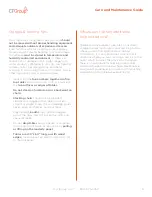
mycfgroup.com
|
800-873-3252
Care and Maintenance Guide
3
General cleaning tips
There are many excellent cleaning products,
including some very effective natural and
environmentally friendly products, available today,
but due to the multiplicity of materials used in
furniture manufacturing it is wise to seek the
manufacturer’s advice for the specific products
and materials used on your products. If you are
unsure, seek the advice of an experienced and
recommended commercial cleaning professional.
You should
never
allow anyone to use harsh
detergents or abrasive cleaners, or soak materials
in water, this will almost always result in product
damage and may even void your warranty. Here are
some tips for specific materials commonly used in
furniture manufacturing, but you should always seek
professional advice from qualified professionals;
•
Wood
: use a liquid cleaner such as a wax polish
combination to clean wood finishes. Use a wax
repair stick to remove minor scratches. Wipe
off any water spills immediately. Never expose
to extreme temperatures or moisture, avoid
exposing wood surfaces to bright sunlight. Coat
wood with a hard wax paste every three to four
months during the first year of use and apply
less frequently after that.
•
Metal:
remove dirt and fingerprints from plated
finishes with a non-abrasive glass cleaner or
damp cloth. Apply furniture polish once every
six months to maintain the surface. Wipe down
powder coat finishes with a damp cloth and
use a light soap and water mixture for stubborn
stains and grease marks. If the finish is chipped,
a touch up paint should be used to prevent
further chipping and corrosion. Remove dirt
from textured powder coat or hammer tone
finishes by brushing with a soft bristle dry brush.
•
Fabrics: a professional service is highly
recommended for all fabrics
since cleaning
methods vary greatly depending on the type of
fabric and the surface treatment which may have
been applied to deliver performance features.
Protective coatings such as Scotchgard, Zepel,
etc must be reapplied every year to maintain
protection. It is important to note that most
flame retardant treatments are salt solutions
and cleaning these treated fabrics with water or
water based foams will result in salt ringing. You
should
test any proposed cleaning method on
a small portion of the fabric before proceeding
with the entire installation. Dirt and crumbs
can be gently brushed or vacuumed off the
surface of the fabric. Spills should be soaked up
with an absorbent paper towel and wiped off
immediately with a cloth before the spill dries in.
•
Vinyl and fused edges:
wipe off all spills to
prevent stains. Use a light liquid detergent,
suitable for cleaning vinyl, and wipe the surface
with a damp cloth after cleaning.
•
Laminates:
apply self-cleaning wax every three
months. Remove stains by wiping the surface
with a damp cloth and soap, or liquid detergent.
Remove stubborn stains with a damp paste of
baking soda, which you should leave on the
stain for a few minutes and then blot away.
Always refer to the manufacturer’s guidelines for
cleaning their products.
•
Plastic shells
: clean with warm water and a
light household detergent, use a soft brush for
stubborn stains.























